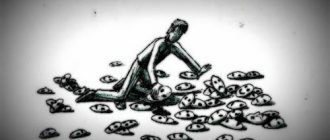I will remember for the rest of my life how difficult and bad it was for me at school. Not a day went by that I didn’t feel inferior and worthless. The only thing I wanted then was for school to end as soon as possible, and it was the worst nightmare of my life. The future did not promise me anything good - several more years of torment loomed ahead. There was no hope, and I gave up. At some point, I locked myself in my room and, it seems, stopped getting out of bed altogether. But nothing ended. The demons did not leave, but took on another form, continuing to torment me from the inside. One day I couldn’t stand it and wrote my last note to my parents. And then she cut her veins. Or rather, I tried. Today I no longer remember whether I had any plans to commit suicide. But I survived. I was admitted to the hospital, a psychiatrist worked with me. And I returned to school.
Today, looking back, I understand that my depression in some incomprehensible way helped me. When I got to the hospital with bandaged hands, it affected me like a cold shower, and I said to myself: “Stop, you can’t go on like this!” Does this mean that if depression had not happened in my life, I would not have become what I have become? I don't have an answer to this question, I just have a feeling that it was necessary.
From the memoirs of Jessica Norton, psychotherapist.
Statistically, one in six Americans suffer from depression at some point in their lives. And this is a huge and impressive number of people. Usually, when people talk about depression, they mean some problem or flaw that makes a person feel a certain way.
But some psychologists think differently. They say that depression is not a flaw or a dysfunction of the psyche at all, but part of the mechanism of evolution, which is designed to gain advantages for the individual in development. And if they are even slightly right, then we should fundamentally reconsider our views on our attitude towards depression.
Ideas that depression plays an important role in the adjustment process are not uncommon in the world of psychology. Anderson Thomson, a psychiatrist at the University of Virginia, notes that the physical and psychological symptoms of depression are not just interconnected, but also form a single, organized system.
Against the background of well-known symptoms of the disease, such as lack of interest in life, indifference to conventional pleasures, inability to engage in any activity, fixation on suffering, very interesting things often happen in depression, for example, analytical abilities improve, and during the REM sleep phase unusual brain activity that is not typical for normal conditions.
Suicidal risk in depression: who wants to die and why?
Everyone knows that modern life is full of stress. However, not every person experiences symptoms of depression or develops suicidal thoughts and intentions. Is there any group at risk for suicide with depression? Who can get into it and for what reasons?
The answer to this question is given by System-Vector Psychology of Yuri Burlan, for the first time accurately differentiating any characteristics, inclinations and properties of the human psyche. According to this science, thoughts of suicide come to mind only to those who have two vectors - visual and sound.
The reasons why depression and suicidal thoughts occur in each of these cases are completely different.
Risk factors
Depression and suicide are concepts between which one cannot confidently put an equal sign. The causes are similar in the two cases, but the latter is considered an extreme consequence of this disease. And if a couple of decades ago any medical report of a suicide indicated a mental disorder, today the true cause is more difficult to identify.
It happens that death at one’s own hands comes as a big surprise to everyone around that person. And none of the relatives can name at least one factor that led to this tragedy.
Despite this, scientists have identified several of the most common causes (risk factors) that most often lead to suicidal depression:
- mental illness;
- alcohol/drug addiction;
- past suicide attempts;
- history of sexual or physical abuse;
- ongoing physical or psychological abuse in the present;
- unfair treatment on the part of the state, society (for example, a guilty verdict against an innocent person);
- constant failures in personal or professional life;
- loss of a loved one.
A person at risk must be constantly monitored in order to provide timely assistance. Depressive behavior is not difficult to spot. The question of how to help a person in such a situation becomes problematic for many people.
Suicidal depression in “not like everyone else”
The zvukovik is a person “not of this world” from birth, but suicidal tendencies and depression do not arise immediately in him. Initially, he is distinguished from other people by special natural aspirations and desires: unlike the carriers of the other seven vectors, the sound person is indifferent to the values of the material world, he is striving to understand the metaphysical questions of existence.
Money and a career, a cozy home and family, “love until the grave” and everything else that people usually strive for is not interesting to him, it does not fill a person with a sound vector. His internal questions can be voiced like this: “Who am I and why was I born on Earth? How is our universe structured, by what hidden laws does it live?” When a sound person does not find an answer to his internal questions for a long time, he gradually develops chronic depression, and later suicidal thoughts appear.
Depression and suicidal behavior as a result of self-isolation
It is not easy for a sound artist to find a common language with people - others consider his interests and views to be strange. And he himself is a natural introvert, focused on his thoughts.
Going deeper into himself, closing himself off from the noisy crowd with its alien values, the sound artist dooms himself to ever deeper depression, suicidal thoughts visit him more and more often. Sometimes I am tormented by the fear of going crazy - getting schizophrenia or another mental disorder. And this is no coincidence: the risk of schizophrenia, autism, and MDP exists only among owners of the sound vector.
Deep depression with suicidal thoughts pushes you to seek some kind of treatment. However, shock courses of antidepressants and other drugs relieve symptoms only temporarily, because treatment with medications does not go away the cause of the problem - debilitating pain of the soul and a feeling of the meaninglessness of life.
Suicidal depression: when to be wary
If someone close to you is experiencing depression with suicidal thoughts, you should be seriously wary if:
- the person has serious sleep disturbances;
- he may not eat for several days and not notice it;
- he wants nothing, nothing pleases him;
- he expresses his depression by talking about the meaninglessness of life, voices his suicidal thoughts;
- Previously, he openly expressed depression and suicidal thoughts, but now he has completely withdrawn into himself and does not even try to share his experiences.
What to do if the listed signs are observed in you or your loved ones? First of all, realize that thoughts of suicide during depression in a sound professional actually have a high risk of ending in suicide. Suicidal depression can lead such a person to the windowsill. As a rule, at this stage he no longer voices anything to others; his severe condition drives him to complete suicide.
A desperate sound engineer can be saved by one conversation from a person who truly understands what is happening to him, one article that reveals to him the reasons for his conditions.
You can try to “talk to the sound artist in his language”, say that you understand the reason for his suffering, that the object of his search is outside the material world, so there is nothing happy here. That he is not the only one in the world - about 5% of people are born with the sound vector.
You shouldn’t try to “help” with the help of unnecessary emotions: “Oh, look at the sun, life is wonderful!” – this will cause nothing but rejection in a person tormented by the pain of his soul.
In case of suicidal depression, the sound specialist is driven solely by getting rid of unbearable mental pain. For his suffering, he blames his body, which seems to “tie” him to this world full of suffering. The sound artist unconsciously hopes that by getting rid of his body, he will also get rid of the pain that has tormented him for so long. However, “getting to God through the back door” is impossible, this is not provided for by nature:
The only way out is in realizing and realizing your natural talents and aspirations of the soul. Here's what people with a sound vector say about this, who completed training in system-vector psychology by Yuri Burlan and got rid of depression, suicidal intentions and behavior forever:
What to do to prevent suicide
In preventing suicide, understanding the motives of the person who decides to commit it plays a significant role. First of all, a deeply depressed person realizes that he is isolated. He feels helpless, abandoned, lonely and useless. It is these feelings that move him to part with the world. A person who has decided to commit suicide is sure that no one is able not only to understand his sadness and pain, but also to relieve it. He regards the attempt to stop his decision to commit suicide as a desire of those around him to prolong his suffering. Helping a person who has decided to make a radical decision should come down to the following principles:
- Participation. The person who is trying to dissuade suicide, or the Rescuer, must first of all assure the suicide that he is completely on the side of the desperate and is able to understand the pain and hopelessness that the Victim feels. Such words are the only correct reaction to the feeling of isolation of a suicide. Limiting Rescuer tactics to just these beliefs is doomed to failure. You need to be so on the side of the Victim that you even agree with participation that death is really the only way out.
- Inducement. After the Rescuer finds a point of contact with the suicide, you can move on to the next principle. It should be used carefully but firmly. First of all, the task is to prove to the Victim that the method he has chosen is wrong. The suicide should be told about what he may lose, what he is now blind and immune to. The most important thing is to explain that after a successful suicide there will be no way to return.
No one loves me, no one feels sorry for me: depression and suicidal thoughts among owners of the visual vector
Sociable and emotional extroverts with a visual vector are completely different from closed and self-absorbed sound people. On the contrary, they actively seek emotional connections with other people and clearly express their feelings. Nevertheless, such people may well complain of stress and depression, and voice their suicidal thoughts.
In fact, in the case of those with a visual vector, we are not talking about deep, chronic depression at all, and the suicidal behavior of such a person does not carry a genuine intention to commit suicide. Where do suicidal thoughts come from in the absence of deep depression?
Naturally visual people have a huge emotional range. Such properties are given to the visual person to realize his properties for the benefit of society. It is the spectators that support all volunteer organizations, peace movements, and work with people with disabilities. In a word, all areas of our life that require compassion for people.
However, in the absence of adequate implementation, this entire incredible range of emotions remains locked inside the psyche of the visual person, which is why he experiences hysterics and emotional swings. Instead of giving love and compassion to others, he begins to demand it for himself. No matter how much loved ones assure him that he is needed and loved, this does not help for long: time passes, and again the need to fill his emotional emptiness arises.
In this state, the viewer can voice suicidal intentions, talk about depression and the unbearability of life. However, these suicidal statements are not filled with depression at all, but with emotional hunger, a desire to receive attention and compassion for oneself. In the absence of the desired reaction from others, the owner of the visual vector in this state may attempt demonstrative suicide.
The suicidal risk with so-called depression (it would be more accurate to say dissatisfaction) in the visual vector is minimal, but it still exists. Sometimes an attempt at demonstration actually ends in suicide. In addition, the viewer, as a rule, is not aware of the reasons for his condition, does not try to consciously manipulate someone, but in fact suffers.
What should you do if someone close to you is experiencing such stress, demonstrating suicidal intentions, complaining of symptoms of depression because no one loves him and no one needs him?
- at a critical moment, give the viewer the much-desired emotions of love and empathy;
- when his condition levels out, try to switch his attention to the real troubles of other people, to involve him in actively helping those suffering.
These tips will help as a temporary measure. To eliminate the risk of repetition of such situations, we need a deep study of psychological problems and traumas that prevent visual people from realizing themselves for the benefit of society.
At the training on system-vector psychology by Yuri Burlan, many people successfully managed to get rid of hysterics, emotional swings, panic attacks and other symptoms of visual deficiency:
Carrying out treatment
Each patient suffers in his own way, and accordingly, treatment is selected individually. Most often these are medications and psychotherapeutic influences. To improve the patient's condition, a number of tranquilizers and antipsychotics are prescribed.
Those who do not know how to get rid of suicidal thoughts can undergo special treatment. Therapeutic methods include, first of all, the conversational part, in which conversations are held with a person. This has a positive effect, the person calms down and tries to understand his own experiences, which prevents relapses of suicide. If the need arises, then relatives and friends are involved in conversations; good results can be achieved through group therapy.
The best solution to a suicidal problem is to diagnose this condition. The person is provided with psychological support, and he will be able to use the acquired knowledge in the future to solve problems that invariably appear on the path of life.
Suicidal depression: there is a way out
Regardless of the reason for which the symptoms of suicidal depression arose in you or your loved ones, the path to relief can only be found through awareness of the deep, psychological causes of this condition. Already at the first free introductory online trainings on system-vector psychology by Yuri Burlan, people get massive results in getting rid of depression and suicidal thoughts. Register here
.
Author of the publication: Evgenia Astreinova, psychologist
The article was written based on materials from the training “System-vector psychology”










